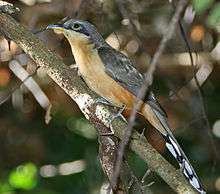Mangrove cuckoo
The mangrove cuckoo (Coccyzus minor) is a species of cuckoo that is native to the Neotropics.
| Mangrove cuckoo | |
|---|---|
 | |
| Scientific classification | |
| Kingdom: | Animalia |
| Phylum: | Chordata |
| Class: | Aves |
| Order: | Cuculiformes |
| Family: | Cuculidae |
| Genus: | Coccyzus |
| Species: | C. minor |
| Binomial name | |
| Coccyzus minor (Gmelin, 1788) | |
| Synonyms | |
| |
Description
Adults have a long tail, brown above and black-and-white below, and a black curved bill with yellow on the lower mandible. The head and upper parts are brown. There is a yellow ring around the eye. This bird is best distinguished by its black facial mask and buffy underparts. Although the scientific name is minor (meaning "small"), this species is on average the largest of North America's three Coccyzus cuckoos. Adults measure 28–34 cm (11–13 in) in length, weigh 64–102 g (2.3–3.6 oz) and span 38–43 cm (15–17 in) across the wings.[2] The most common call heard is a guttural "gawk gawk gawk gawk gauk gauk". It will also call a single "whit".
Habitat and breeding
This cuckoo is found primarily in mangrove swamps and hammocks. It usually nests 2–3 metres (6.6–9.8 ft) above water in a mangrove tree or in a fork of a tree above ground. The nest is a relatively flat platform of twigs and leaves. The female lays 2–4 eggs with both adults sharing in feeding the young bird.
Range and distribution
The mangrove cuckoo is a resident of southern Florida in the United States, the Caribbean, both coasts of Mexico and Central America, and the Atlantic coast of South America as far south as the mouth of the Amazon River.[3] The mangrove cuckoo is generally fairly common in its specialized range. This bird could be threatened by human development of mangrove habitat.
Diet
It prefers caterpillars and grasshoppers, but will also take other insects, spiders, snails, small lizards, and fruit.
References
- BirdLife International (2012). "Coccyzus minor". IUCN Red List of Threatened Species. 2012. Retrieved 26 November 2013.CS1 maint: ref=harv (link)
- "Mangrove Cuckoo Life History". All About Birds. Cornell Lab of Ornithology. Retrieved 2009-07-26.
- "National Geographic" Field Guide to the Birds of North America ISBN 0-7922-6877-6
- Handbook of the Birds of the World Vol 4, Josep del Hoyo editor, ISBN 84-87334-22-9
- "National Audubon Society" The Sibley Guide to Birds, by David Allen Sibley, ISBN 0-679-45122-6
